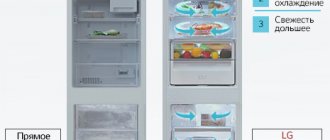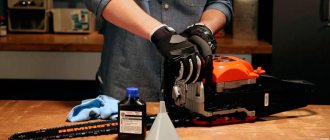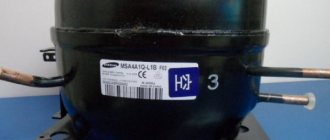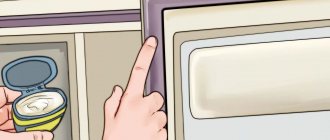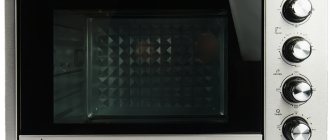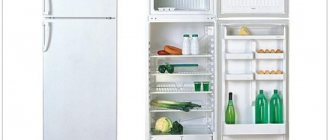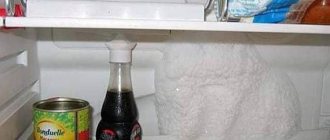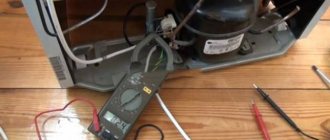For many users, a refrigerator is not only a familiar household device, but an original addition to the kitchen interior. For example, Nevada resident Louise Greenfarb placed more than 32,000 magnets on her refrigerator. For this she was nicknamed the “magnetic lady,” and the collection itself was included in the Guinness Book of Records.
However, first of all, a refrigerator is an important and extremely necessary equipment that allows you to keep food and cooked food fresh and tasty. To ensure the normal functioning of the device, in addition to quality service, it is advisable for the user to become familiar with the operating features and design of the device. In this article we will look at what freon is in a refrigerator, why it is needed and ways to eliminate its leak.
What is freon?
Freon is a substance consisting of a mixture of ethane and methane in a certain proportion. It is inert for the environment. This refrigerant can be in liquid or gaseous form. When a substance evaporates, it absorbs heat and produces a cold reaction. There are more than 40 types of refrigerants. Home refrigeration equipment uses safe ones that are not capable of causing damage to humans and the environment.
It is worth noting that freon is used not only in refrigeration equipment. The substance is used to refill air conditioners and in medical aerosols. The component is contained in polyurethane foam and in paint and varnish products.
Contrary to popular belief that leaks can be detected by smell, modern freon is colorless and odorless. You can find out about such a malfunction only by changing the nature of the equipment operation:
- condensation on the walls;
- insufficient freezing;
- high temperature in the refrigerator compartment (food spoils quickly).
The following types of freon are used for home appliances:
- R600a is a natural substance. Which does not provoke the destruction of the ozone layer of the atmosphere. The disadvantage is its explosiveness at a concentration of 31 g/. In refrigeration equipment, the substance is used in minimal quantities, therefore it is absolutely safe.
- R134a is a safe gas. There is no chlorine in its composition, and no odor appears when it is released. Inert to the environment, non-flammable.
- R12 – Not used in modern household appliances since 2010 due to cases of poisoning. When its concentration in the air exceeds 30% it can cause suffocation.
- R22 is the most common type of freon used in old-style refrigerators (Soviet models). Toxic when exposed to open flame, has a chloroform odor.
Important! Exact information about which freon is used in a particular refrigerator model is presented on the compressor label. Also, the type of substance must be specified in the user instructions.
Freon in a modern refrigerator can be R600a and R134a. Other brands are not used because these are recognized as the safest.
Where is freon located and how is it refilled?
Freon is located in the chamber's evaporator (a system of pipelines through which liquid refrigerant circulates). It absorbs heat and releases cold; the air near the main line quickly cools. Freon circulation is ensured by the operation of the compressor. When heat is absorbed, the liquid is converted into gas. The gas passes to the compressor, condenses and becomes liquid again.
During operation of the refrigeration chamber, it is important to avoid:
- cleaning the freezer from ice with a knife and other sharp objects;
- food and ice getting to the bottom of the evaporator;
- installation near heating devices;
- washing equipment with hot and warm water.
Violating the rules for defrosting the chamber may cause depressurization of the evaporator. In this case, there is a risk of freon leakage; the liquid is quickly converted into gas, and a snow mound forms at the site of the defect.
Ice and snow falling off the surface of the freezer can cause damage to the evaporator. Damage to the pipeline occurs when massive pieces of ice fall to the bottom during defrosting. If you suspect a freon leak, contact a service center.
For reference! Modern refrigerator models contain no more than 200 ml of refrigerant. Its leakage is not dangerous to human life and health. At the first suspicion of a problem, the equipment is disconnected from the network.
You can refill freon yourself if you have experience in leak detection and professional equipment. You will need a special compressor station with pressure gauges; it has two meters (high and low pressure). For refueling you only need a low pressure gauge.
Using a leak detector, the location of the suspected leak is identified, after which the problem area is soldered. Before sealing, all waste refrigerant is pumped out of the tube using a pump. If the pipeline is severely damaged, it must be replaced with a new one. The filling station pipes can only be connected after the evaporator has been restored to functionality.
The process of filling refrigeration equipment with freon requires strict adherence to safety regulations, especially fire safety regulations. Work must be carried out in ventilated areas, ensuring proper ventilation. When contacting a service center, you need to clarify whether they provide a guarantee for their work.
Does it smell like freon?
Freon is an inert gas that boils at sub-zero temperatures and does not ignite when exposed to air. For modern refrigeration units, only safe options that are non-toxic are used, but certain varieties, when heated to 250 degrees, can release toxic compounds, namely phosgene. This substance was used to refill Soviet refrigerators, and after 2010 it was banned from use for domestic purposes.
Nowadays only freon R600a and R134a are used; they have no odor, so it is simply impossible to sense a leak. An unpleasant odor reminiscent of gas may come from a clogged drainage system. You can fix the problem yourself; just clean the capillary tube.
The cause of an unpleasant odor is often due to insufficient maintenance of the equipment. Defrost the unit and wash it using gentle detergents. If you use deodorants or other fragrances in your refrigerator, replace them with new ones. Such devices have a certain service life, so they need to be changed in a timely manner. After their expiration date, an odor similar to ammonia or acetone may appear.
Attention! If you smell burning or burning rubber, do not try to find and eliminate the cause yourself. Most likely, due to a lack of refrigerant, the equipment compressor failed.
If the smell is still there and does not go away for a long time
If the unpleasant odor does not go away after a long time, there may be several reasons:
- Air conditioner malfunctions.
- The drainage system is clogged.
- Incorrect installation of the air conditioner.
Important! To find out the reasons for the appearance of odor in the air conditioner, consult a specialist to eliminate any problems that have arisen.
Experts identify three main reasons for the appearance of unpleasant odors in the climate system:
- Accumulation of ambient aromas in filters. Many air conditioners do not use air from the street, but cool the air in the room. As a result, odors accumulate and are released back in concentrated form. For example, if your new furniture contains a large amount of formaldehyde resins, of course the cooled air will contain them.
Important! Materials such as plastic and synthetics can also be responsible for the odor.
- Mold and bacteria. If the device has not been turned on for a long time, it is possible that microorganisms have accumulated inside, because the device is an ideal environment for reproduction - it is warm and damp.
- Drainage without siphon. If a siphon was not used during installation, and moisture from the air conditioner is removed not to the street, but to the sewer, then the entire smell of sewage can escape and fill your apartment.
How often should you change freon?
Regular refilling of freon is the key to full and uninterrupted operation of household and industrial refrigeration equipment. In industrial refrigeration equipment, the refrigerant is replaced annually; home units most often last until the first breakdown, but acting according to this scheme is not the best solution.
Replacing freon in a refrigerator is a necessary maintenance item, without which the unit may fail. You can determine whether it is necessary to pump in freon by the operation of the equipment. A lack of refrigerant leads to a decrease in the intensity of its cooling ability. Therefore, I recommend paying attention to the operation of the refrigerator. If it becomes worse at freezing or its compartments become warm, you need to seek help. You can fill the unit with freon yourself if you have the necessary equipment. Its separate purchase for the purpose of one-time periodic use is not justified due to the high price.
How to understand where exactly the freon leak is
Signs of refrigerant leakage can be detected by external signs. If there is a crack on the evaporator, a crust of frost or ice will form at its location - this is the main sign of a leak that can be detected independently.
A bulging rear cover of the equipment may also indicate a problem. Move the refrigerator away from the wall and inspect this surface carefully. Blistering is the result of ice forming in the space between the walls. A breakdown is dangerous and expensive to repair. Often you have to look for a replacement back cover.
Do I need to remove freon from the refrigerator before refilling?
If the evaporator is broken, most likely the bulk of the refrigerant has already evaporated from there. If a small amount of the substance remains in the tube, this is not a problem; a small residue will come out along with the air after purging and pressure testing.
Attention! If there is no leak, but work is planned to replace the compressor, we first release the gas. The hose is removed from the room so that the gas escapes outside.
Excessive concentration of freon in equipment is no less dangerous than its deficiency or absence and is not difficult to detect. After filling with freon, turn on the refrigerator for 1-2 hours and periodically monitor its condition. If the capillary tube heats up, and the return tube connected to the pipe is covered with frost, there is a lot of refrigerant. It needs to be reduced to 0.08 MPa.
Possible reasons
Sometimes this problem can occur during defrosting. Some owners are not patient enough waiting for the layer of ice to melt. To speed up the process, they begin to pick at it using a knife or other metal objects. As a result, the risk of accidental damage to refrigerant pipes increases significantly. To reduce the likelihood of such problems, some models use automatic defrosting technology.
There are also other factors that increase the risk of injury. These include:
- Poor quality soldering during previous repairs. After some time, the damage reappears in the same place.
- Presence of defective parts.
- Damage during transportation.
- Problems that arose during the production of equipment: poorly executed assembly, unreliable connections and other similar reasons.
- Typically the evaporator is made of aluminum. It is susceptible to rust. When condensation forms during operation, this leads to increased corrosion processes. This increases the risk of cracks causing refrigerant leakage.
There are statistics on such damage. It is interesting to note that 95% of these occur where the evaporator tube and capillary tube are connected.
Is it possible to turn on a refrigerator without freon?
A refrigerator that is not charged with freon may well work for some time, but with a loss of performance. Due to the lack of refrigerant, the temperature in the chambers will noticeably increase, and eventually it will become equal to the ambient temperature. The question is often asked, is it possible to use the unit if a freon leak is suspected? No, you absolutely cannot do this. A shortage or absence of refrigerant will cause the compressor to work continuously for several days. Ultimately, the motor burns out, and the user will be faced with a choice: buy a new refrigerator or agree to expensive repairs.
Repairing the leak
During the repair process, the technician will look for a leak in the pipe through which freon flows. This is usually done using a special device - a leak detector. When a crack is detected, it emits a beep. Depending on the nature of the damage, spot soldering is performed or the faulty section of the pipe is replaced.
Before starting work, freon is removed from the system using vacuum removal. When the repair is completed, the refrigerant is pumped into the system and the compressor is turned on. After completing the repair work, the technician must make sure that the refrigerator is working properly. One of the important signs is the high-quality operation of the freezer.
Fixing the leak yourself is not recommended. At the same time, it is almost impossible to accurately determine the location of the damage and reliably eliminate it.
Is freon dangerous for humans?
The toxicity and high risk of explosion of refrigerants used in refrigeration units is a myth. This substance is safe for humans and the environment and is contained in the circuit in small quantities. To operate a modern unit, you need from 30 to 100 grams of refrigerant. This mass is more than enough to create the required pressure, and filling above the norm can cause module failure.
From an explosion hazard point of view, the component is also not dangerous. If the operating rules are followed, an explosion is impossible due to the low concentration of the substance. A cylinder with refrigerant can be dangerous, and only if it is located near sources of open fire.
Application
The most well-known industries for using freon are the production of refrigerators and air conditioners. The range of its application is very wide:
- Included in aerosols and sprays in the cosmetic and medical industries.
- Used as a foaming agent in gas cylinders.
- In fire extinguishing agents (for example, gas fire extinguishers).
- In building materials, in the manufacture of polyurethane foam, paints and varnishes.
Freon poisoning
A freon leak in a household refrigerator cannot cause poisoning and, if detected in a timely manner, does not harm the unit itself.
Freon is dangerous only in large quantities, therefore the risk of gas poisoning is increased for people working in cold storage plants, especially if the ventilation system is broken. The consequences of such intoxication are reversible, but quite dangerous, so you need to pay attention to the following symptoms:
- state of alcohol or drug intoxication;
- spots before the eyes;
- convulsions;
- allergic reactions;
- nervous excitement;
- confusion;
- irritation of mucous membranes;
- 1st and 2nd degree skin burns.
Attention! The severity of the victim’s condition directly depends on the number of chlorine atoms in a particular freon. In mild cases, dizziness and headaches appear, and in severe cases, pulmonary edema is possible, which can result in death.
Freon - belongs to a group of substances that require special rules when working with them. It is impossible to ignore such instructions, especially in large production. If a substance is contained in large quantities it is dangerous. At the first suspicion of intoxication, you should seek medical help and undergo treatment.
Three driver mistakes that “kill” the air conditioner in a car
Experts from the AvtoVzglyad portal tested the German aerosol cleaner in action - on one of the editorial cars, in the interior of which an unpleasant musty smell began to appear when the air conditioner was turned on. We purchased the drug and began to prepare for the procedure. As it turned out during the preparation, to use Klima Anlagen Reinigen, the flexible probe (or rather, its counterpart) should first be secured to the lid of the cylinder.
It turned out that the probe is fixed quite tenaciously, which is very important when carrying out preventive treatment. As for the composition itself, according to the attached description, it is an aqueous solution of bronopol, which destroys all known fungi and bacteria, including legionella, which is dangerous to humans. An interesting point: the remnants of bacterial biomass after using the drug, together with the liquid, are removed by gravity through the drainage of the air conditioner, due to which, in fact, the characteristic musty smell is eliminated from the machine.
When using a cleaner, it is recommended to spray two-thirds of the product onto the evaporator, after first removing the cabin filter, and spend the remaining third on treating the air ducts. Our experience has shown that the first stage - dismantling the filter and spraying the evaporator channel - will take ten to fifteen minutes. It will take about the same amount to slowly clean all the air ducts. Using a probe, we treated them through the central air ducts, where we made several powerful injections of a cleaning spray.
Then we carried out a similar treatment of the air ducts through the side deflectors, trying to push the probe with the sprayer deeper into the air supply channels. After completing the chemical cleaning, we had to keep the ventilation system at maximum airflow for another quarter of an hour - for, so to speak, the final purging and drying of the treated air channels. After that, the smell of diaper rash completely disappeared from the car.
Source
Results
Freon is an inert gas, a mixture of methane and ethane in different proportions. It is used to refill various refrigeration equipment. It is odorless and colorless, so it is impossible to detect its leak visually. If there is not enough refrigerant in the circuit, the performance of the unit will decrease.
After determining the reasons, they begin refueling, but first, you need to identify where there is a hole on the evaporator. It is very easy to detect. There will be a crust of ice or frost on the area. If the tube is broken in several places, there is no point in restoring it; buy a new evaporator - it will last longer.
Often the user is concerned with the question, how dangerous is a freon leak? At home, there is absolutely no danger, because non-toxic gas is used for refueling. Poisoning is possible when working at refrigeration plants and factories producing climate control equipment, where this gas is present in large volumes.
Video: how to properly fill a refrigerator with freon with your own hands
How to properly fill a refrigerator with freon with your own hands without a technician and without scales
Watch this video on YouTube
Video: refilling a household refrigerator
Refilling a household refrigerator
Watch this video on YouTube
Do you want to understand better than others?
- How to find a freon leak in a refrigerator and how to fix it - Owners of old refrigerators know that over time the device begins to freeze worse. You have to turn up the power to maximum, and eventually change the refrigerator altogether. Guilt...
- Here's how much and how you really need to store caviar in the refrigerator - Black and red varieties of caviar are valuable products, the composition of which contains a lot of microelements necessary for the body. With the help of caviar you can refine a wide…
- How to rearrange the door on the refrigerator in LG refrigerators - If desired, and if you have the tools, you can rearrange the doors on LG models yourself. However, it should be remembered that re-hanging the LG refrigerator doors yourself must...
- Why you need to store food in the refrigerator - Food is stored in the refrigerator to extend its shelf life, since this device creates conditions that are optimal for slowing down the development processes...
- How to fill a refrigerator with freon with your own hands. Step-by-step instructions for refilling any type of refrigerator with freon - How refrigerators are refilled The operation of a refrigeration unit is based on the conversion of heat into low temperatures. Freon is a gas capable of absorbing heat from the external environment....
Conclusions and useful video on the topic
This shows the process of fixing the leak and pumping freon into the refrigerator using a scale:
The general procedure for performing this type of work can be seen in the video:
Filling a refrigerator with freon is relatively easy if you have the necessary equipment and the appropriate skills. However, it is necessary to take into account a number of nuances: comply with safety requirements, identify and eliminate all faults that caused a refrigerant leak, perform final soldering efficiently, etc.
It is better for inexperienced craftsmen to first observe the work of specialists in order to learn how to perform this operation on their own.
Sources
- https://FB.ru/article/211209/freon—eto-temperatura-freona-freon-v-holodilnike
- https://oventilyacii.ru/ventilyaciya/osnovnye-harakteristiki-i-temperatura-kipeniya-freona-r-410a.html
- https://www.profholod63.ru/poleznaya_informaciya/opisanie_i_sostav_freonov/
- https://homeasking.com/chto-takoe-freon/
- https://VentingInfo.ru/konditsionery/freon
- https://otivent.com/davlenie-freona-v-kondicionere
- https://sovet-ingenera.com/tech/xolodilniki/zapravka-xolodilnika-freonom.html
How do you like the article?
Sergey Vladimirovich
Ask a Question




